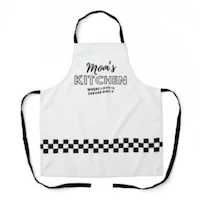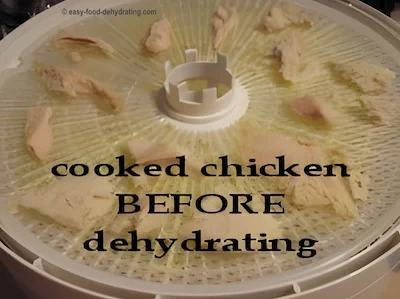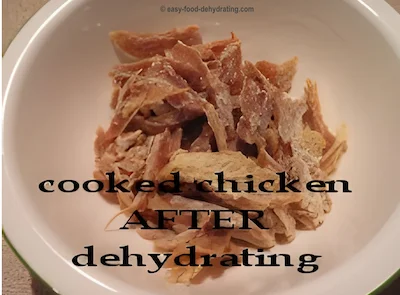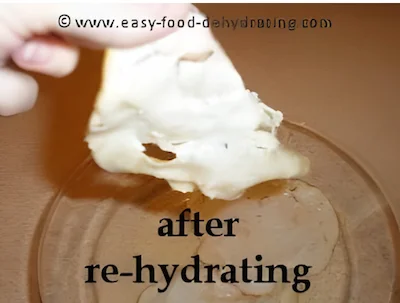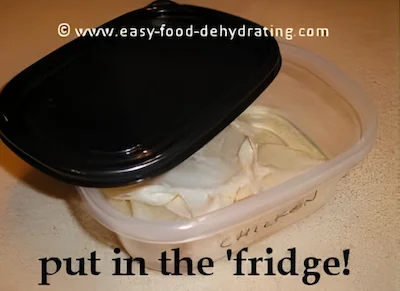whatever the reason or season!
- Home
- How To Dehydrate Chicken
How to Dehydrate Chicken
Using Pre-Cooked, Pre-Sliced Deli Chicken Breast!
If you want to know how to dehydrate chicken safely, keep reading. It's much simpler to use pre-cooked, pre-sliced chicken breast - either sliced fresh at the Deli counter or from meats sold pre-sliced in tubs.
However, I do cover how to dehydrate your left-over roast or baked chicken pieces too!
Chicken BEFORE Dehydrating
Chicken AFTER Dehydrating
Mother's Day Specials!
TOP Frequently Asked Questions:
What's the ideal temperature for dehydrating cooked chicken?
What's the ideal temperature for dehydrating cooked chicken?
Pre-cooked chicken is best dehydrated at 160°F as mentioned on this page you're reading—but please consult your food dehydrator's owner's manual for their specific instructions.
Can you use a regular oven to dehydrate chicken?
Can you use a regular oven to dehydrate chicken?
You can use a regular oven to dehydrate chicken, but it will take longer than using a convection oven. Read more about that further down this page.
How to dehydrate chicken in oven?
How to dehydrate chicken in oven?
This question is answered in the box below.
Can you dehydrate cooked chicken?
Can you dehydrate cooked chicken?
Yes, you can, and it's what I recommend doing. I don't like to dehydrate meat from raw. Read directly below to learn more about the right way to dehydrate cooked chicken, thanks!
How about dehydrating canned chicken?
How about dehydrating canned chicken?
Yes of course! Allow the chicken to drain in a sieve, in the sink. The drier the better (less dehydrating time needed). Follow the instructions below.
How to Dehydrate Chicken on a Dehydrator
Using Pre-Cooked Sliced Deli Meats
How to
Dehydrate Chicken
on a Dehydrator
Using Pre-Cooked
Sliced Deli Meats
1. Arrange your pre-cooked, pre-sliced chicken slices on your dehydrator trays.
2. Don't overlap the slices.
3. Dehydrate on the HIGHER temperature of 160°F until "done" - about two hours.
Rotate your trays for even drying. Yep, I know that's not in the "owner manual" but I do it anyway.
The chicken, when fully dry, will feel quite crisp. Store in food vacuum-sealer bags with a 100cc oxygen absorber added before drawing out the air.
How to Dehydrate Chicken Using a Regular Oven
Dehydrating chicken in a regular oven begins by preheating the oven to its lowest setting. Place the chicken on a wire rack and set it inside the oven. Leave the oven door open slightly to allow air to circulate.
TIP: Use the handle of a wooden spoon to keep the oven door ajar.
Check on the chicken every few hours, and remove it from the oven when it is dehydrated to your desired level.
Keep in mind that it will take longer to dehydrate chicken in a regular oven, so you'll need to be patient. And please remember this: We are NOT dehydrating RAW chicken. We are dehydrating cooked chicken.
In the "rehydrating chicken" area a little further down, I used my favorite sandwich meat in a tub. Yeah, sometimes I don't have time to stand in line at the deli! And here's one great reason to use pre-sliced: they're always uniformly sliced!
If you're going the pre-sliced chicken route, try not to have the slices overlap on the dehydrator trays. It's that easy. Just spread out the slices!
Shown on the dehydrator trays at the top of the page are slices of pre-cooked sliced chicken breast by Hillshire Farms.
The whole package filled four of my Nesco Dehydrator trays with five slices on each tray, and it only took TWO hours for them to become fully dehydrated!
When dehydrating chicken, don't forget to use cooked meats left over from your Sunday roast chicken dinner.
Make sure you evenly slice the pieces and make them of a uniform size; that way they will dehydrate uniformly—i.e. at the same rate of time.
"Leftover Dinner" Chicken Dehydrated:
Use a Higher Heat Setting for Dehydrating Chicken
We use the higher heat setting of 160°F - don't dry meat out on a lesser temperature.
REMEMBER to turn the heat UP to 160°F
never dehydrate meat on a lower setting,
that's not safe (germ-wise).
REMEMBER to turn
the heat UP to 160°F
never dehydrate meat
on a lower setting,
that's not safe
(germ-wise).
Rehydrate in Chicken Stock for Added Tastiness!
Rehydrate in Chicken Stock
for Added Tastiness!
In the photo above, you can see just how crispy the chicken was after dehydrating! I then purposely draped a slice of the rehydrated chicken around my finger so you could see that it was indeed moist again.
Make a small amount of chicken stock (from my favorite Better Than Bouillon) and wow, what a difference it makes to the taste of the rehydrated chicken! Make a note of that! :-)
IMPORTANT: Rehydrate your chicken in the refrigerator in CLEAN water or chicken stock. Don't leave it out on the countertop! Don't let the chicken go 'off'!
Cooked chicken breast can be safely rehydrated after it has been dehydrated. Rehydrating chicken breast is a quick and easy way to add moist, flavorful chicken to your dishes.
To rehydrate chicken breast, soak it in water for about 30 minutes. Then, use the chicken as you would normally use it. The rehydration process will add moisture and flavor to the chicken, making it more tender and juicy. So, if you're looking for a quick and easy way to add flavor to your dishes, you should rehydrate the chicken breast in stock.
Sarah, in Australia, Wants Us to Know This:
"I do a lot of dehydrating for long hiking trips and have found that the canned chicken (that looks like canned tuna) in the supermarket (yes sounds gross) is the only chicken I've been able to dehydrate that re-hydrates exactly like it was prior. Taste and texture on rehydration is perfect for chicken, just remember to buy the low-fat canned chicken."
Hi Sarah! That's really great to know! I actually have used the 'canned chicken' in soups and chicken salad! :-) And yes, the low-fat stops rancidity when storing "long term". Thanks so much for posting!
A Reminder
I also have this reminder on all the 'meat' pages: We only dehydrate cooked meats. It is not safe to dehydrate raw meat at low temperatures. If you want to make beef jerky, please check out our Podcast called Dehydrating Meat + Beef Jerky Recipe!
Dehydrate Cooked Pork Too!
This morning I had Robert S. write in to ask if it's OK to dehydrate cooked pork.
Answer: YES... (here's how!)
I also thanked him for bringing it to my attention that I hadn't listed PORK (the other white meat!) alongside the chicken, turkey, and beef! I have now, and here is how to dehydrate pork.
Thanks!



